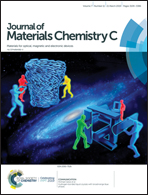Human hair keratin for physically transient resistive switching memory devices†
Abstract
Biomaterials have attracted attention as useful structural components in biodegradable and transient electronics due to their solution processability, biocompatibility and bioresorbability. In this work, we report the thin films of biocompatible keratin from human hair as the solid electrolyte layer in resistive switching memory devices, exhibiting great electrical performance, high transmittance, and physically transient property. This non-volatile memory device exhibited reproducible resistive switching performance, uniform switching voltages, and a concentrated distribution of low and high resistance states. The resistive switching mechanism of the Ag/keratin/FTO device was described via the electrochemical formation/rupture of the Ag metallic filament in the keratin layer. In addition, the keratin thin films could be dissolved in deionized water within 30 minutes, presenting the potential biodegradability and physically transient characteristics of the memory devices. These biocompatible memory devices are environmentally friendly, sustainable and inexpensive and act as promising candidates for memory applications.



 Please wait while we load your content...
Please wait while we load your content...